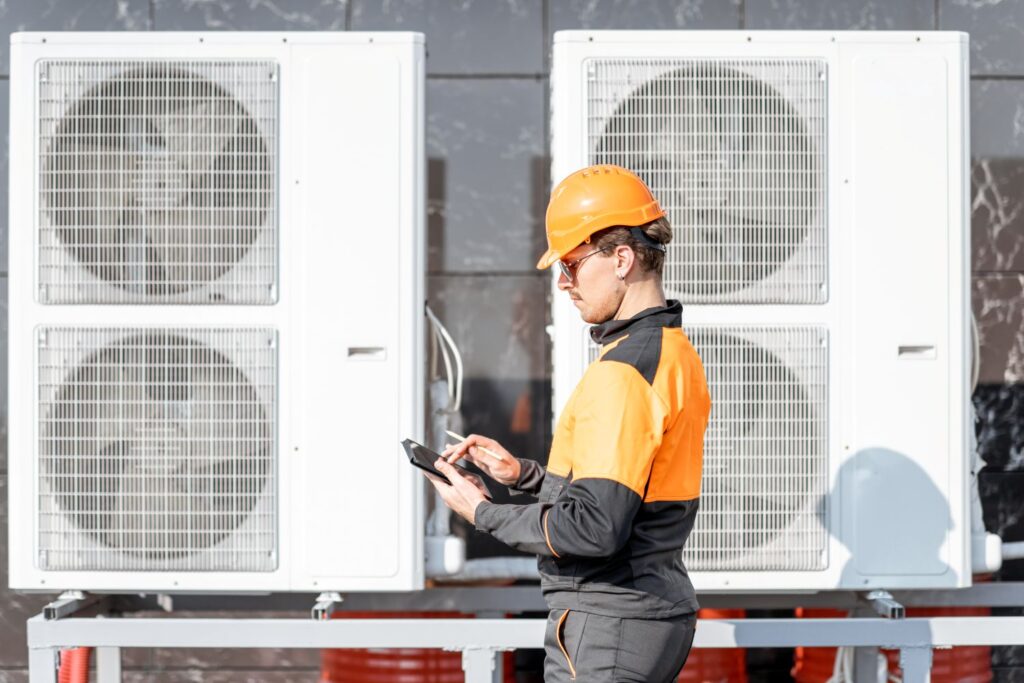So you’ve finished your basement—hello home gym, guest suite, man cave, or epic movie room! But wait… why is it still freezing down there? Or worse—stuffy and humid like a laundry room in July? If you’re dealing with uneven temps, poor airflow, or just plain uncomfortable vibes, you’re not alone. Many St. Clair County homeowners forget one critical step in their lower-level remodel: a proper HVAC installation designed specifically for basements.
At S&P Heating, we’ve seen firsthand how overlooked basement climate control can totally derail the comfort (and usefulness) of your space. So, whether you’re finishing a brand-new basement or realizing your old system isn’t cutting it, this guide will walk you through finished basement HVAC solutions that actually work.
Let’s dig into what makes basement heating and cooling unique—and how to do it right the first time.
Why Basement HVAC Isn’t a Copy-Paste of Upstairs Solutions
Here’s the thing: basements aren’t just another floor. They’re below-grade, which means they come with their own set of quirks. Think cooler temperatures, more moisture, limited airflow, and typically low ceiling HVAC solutions. Simply tapping into your upstairs ductwork may not be enough—or even smart.
Challenges unique to basements include:
- Basement humidity control due to poor ventilation or exposed concrete
- Uneven basement temperature if the ducts weren’t designed for finished spaces
- Limited return air vent placement options
- The need for quiet HVAC units for basements (no one wants to watch a movie with a rumbling blower nearby)
- And let’s not forget: ventilation code requirements that apply in St. Clair County
In other words: it pays to plan HVAC for basements intentionally.
Option 1: Extending Your Existing System
If your current furnace and AC have enough capacity, you might be able to extend your ductwork into the basement. This is common in newer homes where systems were sized with future finishes in mind.
Pros:
- Cost-effective if ducts are already nearby
- Keeps everything on one thermostat
- Great for open layouts or multi-room basements
Cons:
- May cause an imbalance on the upper floors
- Can strain older or undersized equipment
- May require duct redesign for proper basement HVAC zoning
This is where a contractor with experience in ductwork installation in St. Clair County is key. Poorly executed extensions can lead to pressure imbalances, uneven airflow, and higher energy bills.
Option 2: Installing a Mini-Split System for the Basement
Looking for flexibility, energy efficiency, and zero duct drama? A mini-split system for basement use is a top choice, especially for large finished spaces or those with segmented rooms.
Why mini-splits are a great fit:
- No ducts required
- Individual temperature control
- Whisper-quiet operation
- Excellent for retrofitting HVAC for basements in older homes
- Some models include dehumidifiers—great for that below-ground funk
You can install one wall-mounted unit for the whole space, or multiple for zoned control. It’s a sleek, modern solution that’s also perfect for conditioned basement spaces like offices, gyms, and guest rooms.
Don’t Forget the Return Air—It’s Not Optional
A major mistake we see in basement projects? Skimping on return air vent placement. If supply vents blow warm or cool air in but there’s nowhere for that air to exit, the system won’t circulate efficiently.
Good return air design =
- Better airflow
- Balanced pressure
- More consistent temperature
- Improved air quality
Whether you’re extending ducts or going ductless, make sure your system includes a solid return air strategy. It’s not glamorous—but it’s essential.
Below-Grade Insulation = Efficiency Gold
Your HVAC system can only do so much if your basement walls and floors aren’t properly insulated. That cool, damp feeling? It might not be your AC—it might be the earth pushing moisture and chill into your walls.
Add insulation to:
- Basement walls (especially concrete)
- Rim joists and headers
- Underneath the floors, if converting a walk-out basement
Proper insulation supports quiet HVAC units for basements and allows your system to run less often and more efficiently.
What About Utility Room Placement?
Got a furnace or water heater in your basement? Make sure your HVAC installation plan doesn’t interfere with access, code compliance, or airflow from these appliances.
Basement utility areas often have specific ventilation code requirements, especially when it comes to combustion appliances. Always work with a licensed contractor to ensure your plan is safe and up to local standards.
Sizing Your System Right
Don’t guess when it comes to equipment size. Your contractor should perform a load calculation to determine the exact capacity needed for your finished basement.
A system that’s too small will run constantly and still underperform. One that’s too big may short-cycle and wear out faster. This is especially true with mini-split systems for basements, which come in different capacities for a reason.
HVAC Zoning: Control Where You Need It
If your finished basement is being used as a separate space—say, a guest suite or home office—it might be time to think about basement HVAC zoning. This allows you to heat or cool the basement independently from the main floors.
Benefits of zoning:
- Custom comfort
- Reduced energy waste
- Lower utility bills
- Better temperature balance in the whole home
Your zoning options may include dedicated thermostats, automatic dampers, or dual-stage systems that adjust output depending on demand.
Basement Air Quality Matters
Basements tend to harbor more moisture, dust, and allergens than other parts of the home. So when you install HVAC, take the opportunity to also improve air quality.
Consider adding:
- Dehumidifiers (standalone or integrated)
- HEPA filters or upgraded MERV filters
- UV lights to neutralize mold and bacteria
- Fresh air intakes to reduce stuffiness
When your HVAC system is handling temperature and air quality, you’ll get a truly conditioned basement space, not just a climate-controlled cave.
📞 Let S&P Heating Help You Create the Perfect Basement Comfort Plan

Finishing your basement is an exciting upgrade, and S&P Heating is here to make sure your HVAC installationsupports your vision from the ground up (literally). Whether you’re adding a ductless system, retrofitting ductwork, or just need guidance on insulation and airflow, our team brings experience, precision, and a whole lot of basement know-how.
Give us a call today and let’s transform your lower level into the most comfortable space in the house.
❓ FAQ: What Else Should You Know About Basement HVAC?
Can you use space heaters instead of extending the HVAC into your basement?
While space heaters can be a temporary fix, they’re not as efficient or safe as a long-term solution. They can’t manage humidity, airflow, or air quality, and they often create temperature imbalances. A proper HVAC solution—ducted or ductless—is always the better investment for both comfort and safety.
Is a dehumidifier enough to control basement comfort in the summer?
A dehumidifier can help, especially in damp St. Clair County basements, but it won’t replace the cooling power of an AC or mini-split. It’s best used as a supporting tool alongside a full HVAC system to manage moisture and prevent musty odors or mold growth.
How does HVAC installation affect resale value in finished basements?
Proper HVAC in a finished basement can absolutely boost resale value. Buyers love additional conditioned living space, especially when it’s professionally climate-controlled. Incomplete or inefficient systems, on the other hand, can raise red flags during inspections or appraisals.
🔗 Let’s Talk Green HVAC Goals
If you’re wrapping up a basement project, now’s the perfect time to think big-picture. Head to our next article: “The Truth About Furnace Filters: Sizes, Ratings, and Replacement Myths”. You’ll discover smart thermostat tricks, system recycling tips, and how to make your HVAC install the most eco-conscious move you make all year.



